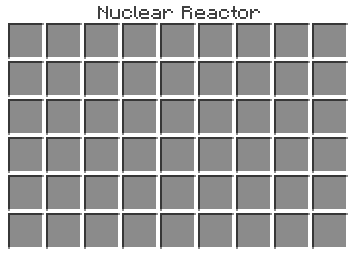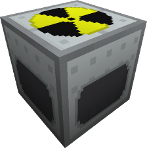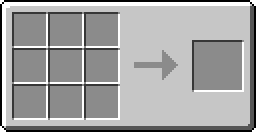Nuclear Reactor
| Nuclear Reactor | |
|---|---|
| Properties | |
| Type | Generator
|
| Stackable | Yes (64)
|
| Technical Details | |
| UU Cost | {{{uu_cost}}} |
| First appearance | ? |
| ID | IC2:{{{id}}} |
|
| |
The Nuclear Reactor is a known generator to produce EU.
With IndustrialCraft² the reactor system is fully recoded!
Instead of lame Uranium refining, you have to make a good setup for your reactor with all the reactor stuff you can find in the navigation.
But one thing wasn't completly changed: The nuclear melting.
In IC² the reactor can hold a value of heat, which get produced by producing energy with Uranium Cells. This heat can be reduced by stuff like Cooling Cells , Integrated Heat Dispensers and so on.
In addition you can make your reactor bigger with Reactor Chambers. You can have 6 additional Reactor Chambers.
Recipe
GUI
 
|
This is the new GUI: (Fully upgraded with 6 additional Reactor Chambers) Don't think about using them as a mad scientist's large chest, a reactor will spit out any item that is unrelated to it's function. |
Usage
Reactors are complex and not for the faint of heart, a bad design can suddently replace your house with a nice new crater.
Reactor Terms[edit]
Here are some of the terms often use when describing a reactor and it's design.
Reactor Tick: A reactor 'ticks' once every second, this is when heat, EU generation and cooling is calculated.
Reactor Design: The pattern in which components are place within a reactor, a good design can give you nice safe energy and a bad design can spontaneously crater-ize your home and it's contents.
Uranium Pulse: Pulses occur during a reactor tick producing heat and EU for each uranium cell, uranium cells placed next to each other will interact produce multiple pulses per reactor tick.
Heat: The reactor itself and it's components can all store heat, if heat levels gets too high then components will melt and there will be a risk of a reactor meltdown. ( Boom! )
Cooling: Cooling is provided by internal components like a Cooling Cell and the outside enivronment like water. Cooling is needed to counteract the effects of heat and hopfully keep your reactor (and home) intact.
Reactor Hull: This is where heat goes when it's not stored in a component. The maxium heat storage is 10,000 but it can be increaced with Reactor Chambers and Integrated Reactor Plating
Reactor Class: All reactor designs can be a class like "Mark-I-O ED" or "Mark-III EB" which gives an indication of how well a design will perform.
Reactor Efficentcy: The amount of EU generated per Uranium Cell used, the more uranium cells that are placed next to each other, the higher the efficency but also higher the risk.
Breeder Reactor: A type of reactor design that produces little energy, it purpose it to recharge Depleted Isotope Cells into full Uranium Cells
Reactor Components[edit]
A list of the various components that can be used within a reactor.
Reactor Chamber: Not really an interal component, these are placed adjacent to the reator block in order to increase the number of slots within a reactor, increase the stength of the hull (+1000) can add a small amount of cooling.
Uranium Cell: The key part of a reactor and each cell will pulse one or more times, producing heat and EU, each reactor tick. On it's own, a cell will only pulse once per tick, but if one or more uranium cells is adjacent then the cell will pulse again for free. A uranium cell will last up 10,000 reactor ticks (2 hours 47 minutes), generating anywhere between 1,000,000 to 5,000,000 EU depending on the effiency of the design. Uranium cells have a chance to turn into Near-Depleted Uranium Cells when they're used up.
Cooling Cell: A single cell can store upto 10,000 heat away from the reactor hull, any more heat will cause the cell to melt. The cell will also cool 1 point of it's stored heat each reactor tick.
Integrated Reactor Plating: Plating will distribure heat from an adjacent uranium cells into surrounding cooling cells and also into other plating to be futher distributed. Distributing hear to another plating only happens once, the second plating will not distrubtute to a third plating. Plating also increases the reactor's hull strength (+100) and can store upto 10,000 heat itself if it is unable to direct it into a cooling cell, this stored heat will disipate at a rate of 0.1 per reactor tick.
Integrated Heat Dispenser: These components will attempt to balance out the levels of heat within the reactor hull, itself and any adjacent component cabable of storing heat. During each tick the dispenser can give/take upto 25 heat from the reactor hull and give/take upto 6 heat from each of the surrounding components.
For example, if a reactor hull has 120 heat stored and fresh dispenser is placed inside and surrounded by cooling cells then the dispenser will begin balancing the heat levels until the hull, itself and the cooling cell all have 20 heat each.
Near-Depleted Uranium Cell: The 'empty' state of a uranium cell, these can be made manually or have a chance of appearing when a uranium cell runs dry within a reactor. They produce 1 heat each reactor tick.
Depleted Isotope Cell: A depleted uranium cell mixed with coal dust, when placed next to a uranium cell it recharge into a full cell once again. Isotope cells produce 1 heat and will cause adjacent uranium cells to pulse an additional time each tick, this extra pulse will produce heat but not EU. Isotope cells charge much faster if the reactor is running very hot.
Re-Enriched Uranium Cell: The fully charged state of an isotope cell, it will continue to produce only 1 heat and no EU but it will no longer react with adjacent uranium cells. Combined with another coal dust to become a brand new uranium cell.
Water Bucket: When a reactor's hull has more than 4000 heat, it will evaporate the water reducing the heat level by 500 and leaving the empty bucket behind. (The reactor won't spit it out)
Ice Block: Each reactor tick, if a reactor's hull has more than 200 heat it will evaporate the 1 ice block reducing the heat level by 200.
Lava Bucket: A lava bucket will increase a reactor's hull heat level by 2,000 and the empty bucket will remain in the reactor. This is useful for 'breeder' type reactors while recharing isotope cells.
Heating and Cooling[edit]
Almost every component and the reactor itself can store heat in an effort to stave off a disater, it is upto the cooling systems (and 'you') to get rid of this accumulated heat before the reactor cannot take any more.
The reactor's own storage (known as the reactor hull) starts of at 10,000 but that can be increased by extra chambers (+1000) or placing plating into the reactor (+100). If the reactor hull reaches 50% of it's maximum heat storage then nearby water will begin to evaporate and at 85% the reactor has a change of removing itself from existance... violently.
Heat stored in components will be safely tucked away from the hull but it will need time for the cooling systems to quench it all.
The most common source of heat is uranium cells, they will produce heat for each pulse they perform. The ammount of heat depends on how many cooling components are adjacent to the cell:
| No. of Components | Heat Generated |
|---|---|
| 0 | 10 per pulse into the reactor hull |
| 1 | 10 per pulse into component |
| 2 | 8 per pulse, 4 for each component |
| 3 | 6 per pulse, 2 for each component |
| 4 | 4 per pulse, 1 for each component |
More cooling systems around a uranium cell mean less overall heat to deal with, making the reactor safer, but it also reduced the potencial amount of EU a cell can produce. Risk vs. Reward.
Depleted Isotope cells only produse 1 heat per tick themselfs, but they still react with adjacent uranium cell and make them pulse additional times.
Near-Depleted Uranium Cells and Re-Enriched Uranium Cells produce 1 heat per tick.
There are several ways to reduce a reactor's heat each tick:
|
* Both still and flowing water count. ** Torches, redstone and similar items won't count. |
* Cooling only occurs if the component in question has any heat stored. |
The maximum outside cooling possible is 33 (Reactor, 6 chambers and 20 water blocks)
If the amount of cooling availible is less than the amount of heat produced then the reactor will gradually collect heat, there are various ways to deal with this:
- Make a design that only has a slight amount of excees heat so that even when the uranium cells are used up the heat levels are still not dangerous.
- Manually drop Ice blocks and/or Water buckets into the reactor
- Apply redstone current to the reactor (or one of it's chambers), causing it to stop generating heat and EU for as long as the redstone current is active.
Heat management for a 'breeder' type reactor is different, breeders work best when running hot so it's best to make a design that has exactly the same heat and cooling amount then manually boosting the heat by adding lava buckets, removing cooling or temporarely adding extra uranium cells.
Reactors will emit smoke particles when warm and fire particles when hot, be carful when using lava buckets as the 2000 heat goes directly into the hull and the heat dispensers need time to pull all that into the cooling systems.
| |||||||||||||||||||||||||||||||||||||||||||||||||||||||||||||||||||||||||||||||||||||||||||||||||||||||||||||||||||||||||||||||||||||||||||||||||||||||||||||||||||||||||||||||||||||||||||||||||||||||||||||||||||||||||||||||||||||||||||||||||||||||||||||

